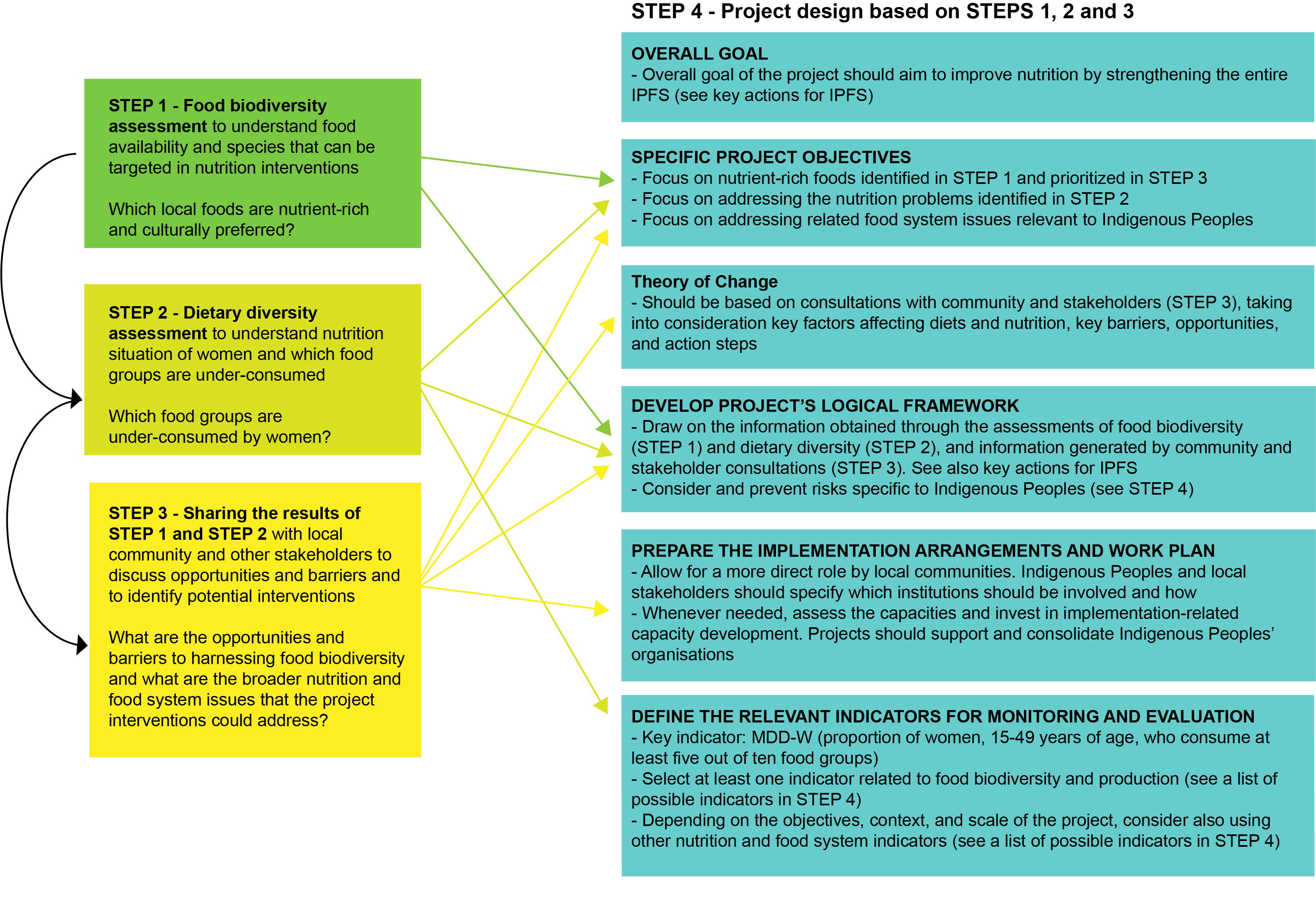
The final step involves developing a project design based on the outcomes of the food biodiversity assessment (STEP 1), dietary diversity assessment (STEP 2), and consultations with Indigenous Peoples’ communities and other stakeholders (STEP 3). STEP 1 ensures that the project is designed to leverage local biodiversity to tackle women’s and household nutritional gaps as identified in STEP 2. Importantly, STEP 3 facilitates the inclusion of the local communities into decision making about project activities. Nonetheless, the project design and implementation processes must follow a policy of ethical engagement with Indigenous Peoples. Adhering to an intercultural approach throughout project implementation ensures that the project genuinely addresses Indigenous Peoples' views, knowledge, experiences, and aspirations.
Box 6. Project example - Improving nutrition (and wellbeing) of Khasi Indigenous Peoples in North-East India
North East Slow Food and Agrobiodiversity Society (NESFAS), an Indigenous Peoples’ NGO based in North-East India, implemented a project called, “No One Shall Be Left Behind: Biodiversity for Food, Nutrition and Energy Security for 3000 Households in Meghalaya and Nagaland”, with the aim to improve livelihoods in 130 villages by strengthening IPFS. Project activities commenced only after thorough consultations were completed with community members of the 130 villages and a FPIC agreement was signed with each participating village. Mapping of food biodiversity and associated local knowledge was conducted to document and prioritize preferred foods. This was followed by the dietary diversity assessment, which helped to identify consumed and under-consumed food groups. The results of these two assessments, along with key food system issues, were discussed with the local communities, and action plans were co-created. These assessments and consultations were used to inform and adjust the project interventions such as cooking demonstrations; food festivals; nutrition and WASH and campaigns; midday meals and school gardens; agrobiodiversity walks; agroecological production; and seed sharing initiatives.

3. Develop the Theory of Change (TOC)
The Theory of Change (TOC) is a useful tool in identifying limiting factors in a project plan and making adjustments to eliminate them. TOC should build upon or reflect the information gathered in consultations with the local communities and stakeholders (STEP 3). The generated information on the factors affecting diets and nutrition, key barriers, opportunities, and action steps (Table 5), provide a solid base for the development of TOC and a logical framework. The development of TOC should also reflect on the main theme of the investment (e.g., agroecology, food systems, value chains, rural development, etc.).
4. Develop Project’s Logical Framework
Development of a logical framework (or logframe) for projects improving diets and nutrition through IPFS should draw on the information obtained through assessments of food biodiversity (STEP 1) and dietary diversity (STEP 2) and knowledge and ideas generated by the consultations of community and stakeholders (STEP 3).
Developing a logframe typically includes indicators with quantifiable targets and suggested means of verification for monitoring and evaluation. It also pushes designers to reflect on assumptions and possible risks. Indigenous Peoples have worldviews, rights, local resources, as well as risks and challenges that are different from non-Indigenous societies. Therefore, when working in Indigenous Peoples’ territories, it is crucial to consider and prevent specific risks. Examples of assumptions specific to Indigenous Peoples that can lead to risk are as follows:
• Indigenous Peoples’ collective rights to their lands and territories are respected, and communities are eager to promote the biological and cultural diversity of their food systems;
• Households have secure land tenure and enough land to produce selected foods. The biodiversity of the local landscape/food system is adequate for provisioning nutritious foods;
• There is enough interest to take part in activities that combine traditional and contemporary knowledge to make the best use of local nutritious foods;
• Producers are willing to combine their traditional practices with new agroecological methods. Trainers have sufficient knowledge and skills on intercultural approaches for weaving traditional and contemporary knowledge and practices;
• Indigenous women do not face significant constraints and barriers to producing, cooking, and consuming local nutritious foods;
• Communities are open to learning and adapting improved food processing and storage technologies, and are prepared to benefit equitably from increased availability and added value of foods and food products;
• The project team has the capacity to communicate in a way and language that Indigenous Peoples’ communities fully understand;
• The project delivers locally suitable and feasible technologies that the communities can sustain beyond the project, without breaking transmission of existing traditional knowledge and methods.
IFAD's Social, Environmental and Climate Assessment Procedures (SECAP), which lays out a framework for managing risks and impacts, and aims to achieve better development outcomes in IFAD investments, provides relevant guidelines valuable during the early stages of the design process. The SECAP Standard 1 on Biodiversity Conservation recognizes that biodiversity is about people and the need for food security, medicines, fresh air and water, shelter, and a clean and healthy environment, and that diversity in agroecological systems builds resilience of rural families and their farming systems. Standard 4 on Indigenous Peoples emphasizes that projects must examine the potential risks to Indigenous Peoples, including their rights, lands, territories, resources, and livelihoods, as an integral part of assessing the project’s full range of potential adverse social and environmental impacts.
More details and general guidance on project design, theory of change, logical framework, and monitoring is available elsewhere (4,5), or in other relevant manuals.
5. Prepare the Implementation Arrangements and Work Plan
The implementation arrangements and work plan should allow for a more direct and defined role by local communities. Indigenous Peoples and local stakeholders should specify which institutions should be involved and how.
While certain interventions can be largely community-based, some complex interventions requiring transdisciplinary and multi-sectoral actions will need to build partnerships and collaborations with various experts and stakeholder groups such as local health workers, governmental extension agents, farmer/women’s groups, teachers/students/schools, religious and cultural bodies, NGOs and CSOs, development organisations, and others. This can be clarified during the implementation arrangements and work plan development.
If there is uncertainty about stakeholders' capacity for implementation, then an assessment of their technical, labour, and financial capacity should be conducted. It is important that the project team has the capacity to implement, backstop, monitor, report, and troubleshoot. Whenever needed, capacity development should be planned and delivered. Projects should support and consolidate Indigenous Peoples’ organisations at local and territorial levels (6).
Inclusive partnerships that strengthen Indigenous Peoples’ agency and local stakeholders' capacity can help to ensure that improvements will continue even when the project has finished. This could be an approach for the project exit strategy to improve sustainability. Whenever possible, existing projects and programs should be reviewed, and synergies that maximize nutritional outcomes through sustainable food systems prioritized. Finally, costing will depend on the type, complexity, and scale of the intervention. Context-specific information will need to be collected and considered. In general, costing should consider all the inputs required for each activity and costs per unit.
6. Define the Relevant Indicators for Monitoring and Evaluation
Monitoring should be done at different stages (baseline, midline, endline) of the intervention to capture the intermediate results and to navigate the right impact pathway. Appropriate key indicators, such as the proportion of women reaching MDD-W, can be used to regularly monitor progress on the impact on diets in the target population. MDD-W is one of three nutrition core indicators adopted by IFAD (7); the other two are the percentage of the targeted population who have improved Knowledge, Attitudes and Practices (KAP) of food, feeding, caring, and hygiene; and the output indicator (the number of households provided with support to improve their nutrition).
Below is a list of recommended indicators and possible metrics related to diet, nutrition, and nutrition-related knowledge, but also to other areas as food systems have multiple interrelated components and outcomes. Many of these indicators (especially related to nutrition, socio-economy, and wellbeing) should be disaggregated by gender and age to control for intra-household variations. Note that some of the listed indicators would require additional methods beyond those explained in this toolbox.
While the list below provides diverse options of possible indicators, each project should choose, adjust, or further specify the indicators (including output and outcome levels) and targets according to the project goal and objectives. More comprehensive monitoring would provide a better understanding of the intervention's impact on both social and ecological outcomes. Whenever possible, more holistic monitoring employing mixed-methodologies (quantitative and qualitative) that give space for participatory assessment, qualitative interviews, and observations should be conducted.
Resources with a more detailed description of indicators and with additional food system-related indicators are available (8, 9, 10, 11, 12, 13). For general indicators used by IFAD, see Core Outcome Indicators measurement guidelines (COI) – online training. IFAD staff additionally can refer to the Core Indications Manual (14). Several of IFAD’s core indicators include multipliers to disaggregate data by Indigenous Peoples. There is no specific compendium of indicators for IPFS, but related older sets of indicators are available (15, 16). TEBTEBBA published A Resource Book on Indicators Relevant for Indigenous Peoples. And the Indigenous Navigator provides tools, data, and indicators that can be used for monitoring the level of recognition of Indigenous Peoples' rights. The Indigenous World reports by IWGIA do not provide a guide on indicators, but they are a comprehensive resource on the situation of Indigenous Peoples’ rights worldwide. In the future, the development of specific metrics and indices for IPFS is recommended.
Importantly, participatory engagement of the community during the monitoring and evaluation process can also empower community members and strengthen the sustainability of the project. This is in alignment with SECAP, which stresses that Indigenous Peoples and knowledge experts should jointly monitor implementation throughout the full duration of the project cycle.
Lastly, monitoring and evaluation should generate valuable information and lessons that must be returned to local communities and stakeholders. The findings will also generate evidence that can be used for advocacy and policy work at the local, regional, national, and global levels.
- proportion of women (15-49 years of age) who consume at least five out of ten food groups (MDD-W)
- proportion of children (6-23 months of age) who consume at least five out of eight food groups
- mean dietary diversity score (average number of food groups consumed by a population)
- proportion/number of consumers with increased consumption of target food groups
- proportion/number of women consuming iron-rich foods
- proportion/number of consumers with increased number of fruit and vegetable servings
- proportion/number of adult consumers who eat at least five servings of fruits and/or vegetables per day
- proportion/number of consumers with increased dietary species richness
- proportion/number of consumers with decreased share of ultra-processed foods in diets
- proportion/number of children and youths accessing and consuming school meals made from local food biodiversity
- proportion/number of households with increased share of income spent on non-starchy staples
- proportion/number of persons with reduced incidence of foodborne diseases
- proportion/number of persons with reduced incidence of diet-related non-communicable diseases
- proportion of persons with improved Knowledge, Attitudes and Practices (KAP) of food, feeding, caring, and hygiene
- proportion/number of households with increased diversity of crops and livestock produced
- proportion/number of households maintaining traditional crop varieties and animal breeds
- proportion/number of persons with increased knowledge and use of wild edible plants and animals
- proportion/number of persons with improved access to food biodiversity
- proportion/number of households with increased production/productivity of local nutritious and climate-resilient foods (prioritized food groups or target foods)
- proportion/number of households with improved agroecological and regenerative practices
- number of established community seed banks keeping autochthon seed varieties
- number of persons served by the established seed banks keeping autochthon seed varieties
proportion/number of persons/communities with recognized rights over land and natural resources
- proportion/number of persons with reduced/no experience of discrimination as prohibited in international human rights law
- proportion/number of persons/households with improved livelihood or increased income derived from local biodiversity, food systems, and territories
- proportion/number of groups/enterprises with improved food processing skills and sustainable technologies
- proportion/number of persons with increased level of local knowledge and languages
- proportion/number of women with increased control of income and ownership of assets
- proportion/number of women with increased power in decision-making
- proportion/number of women empowered in agriculture (women's empowerment in agriculture index - WEAI)
- proportion/number of children, youths, and adolescents with improved access to education
- proportion/number of youths, adolescents, and young adults with enhanced knowledge, skills, and experiences for decent employment and entrepreneurship
- number of schools and educational programs integrating and passing traditional knowledge
- proportion/number of households with improved access to safe water supply
- proportion/number of households with improved access to healthcare and insurance
- proportion/number of households with improved access to markets and supply chains
- proportion/number of households with reduced food insecurity (food insecurity experience scale - FIES; or household food insecurity experience scale - HFIES)
- proportion/number of households with increased access to food (months of adequate household food provisioning - MAHFP)
- proportion/number of households with increased household dietary diversity (household dietary diversity score - HDDS)
- proportion/number of persons with improved other wellbeing indicators (wellbeing indicators defined locally in a participatory way - capabilities approach)
- number of Indigenous Peoples’ communities consulted that provided free, prior and informed consent to the proposed project
- number of Indigenous Peoples’ representatives involved in project management/district units
- number of Indigenous Peoples’ representatives involved in project supervision and evaluation missions
- status of biodiversity of wild plants and animals
- enhanced vegetation index or ecosystem integrity
- landscape area under sustainable management
- coverage of areas under traditional governance
- coverage of restored or rehabilitated land
- coverage/proportion of land resilient to natural hazards and climate impacts
- status of water quality of ecosystems
- quality and health of the soil
- pollution levels in agro-ecosystems
- resilience to climate change (IFAD’s how to do note – Measuring climate resilience)
- proportion/number of households using multiple land-use systems for agriculture and food acquisition (resilience in the diversity of land-uses)
- number of active traditional solidarity mechanisms in place (e.g., mutual and communal work, barter, food sharing and donations, free food, and care for the vulnerable)
- proportion/number of communities with increased resilience of socio-ecological production landscapes and seascapes (indicators of resilience in socio-ecological production landscapes and seascapes - SEPLS)



Made with
Drag & Drop Website Builder